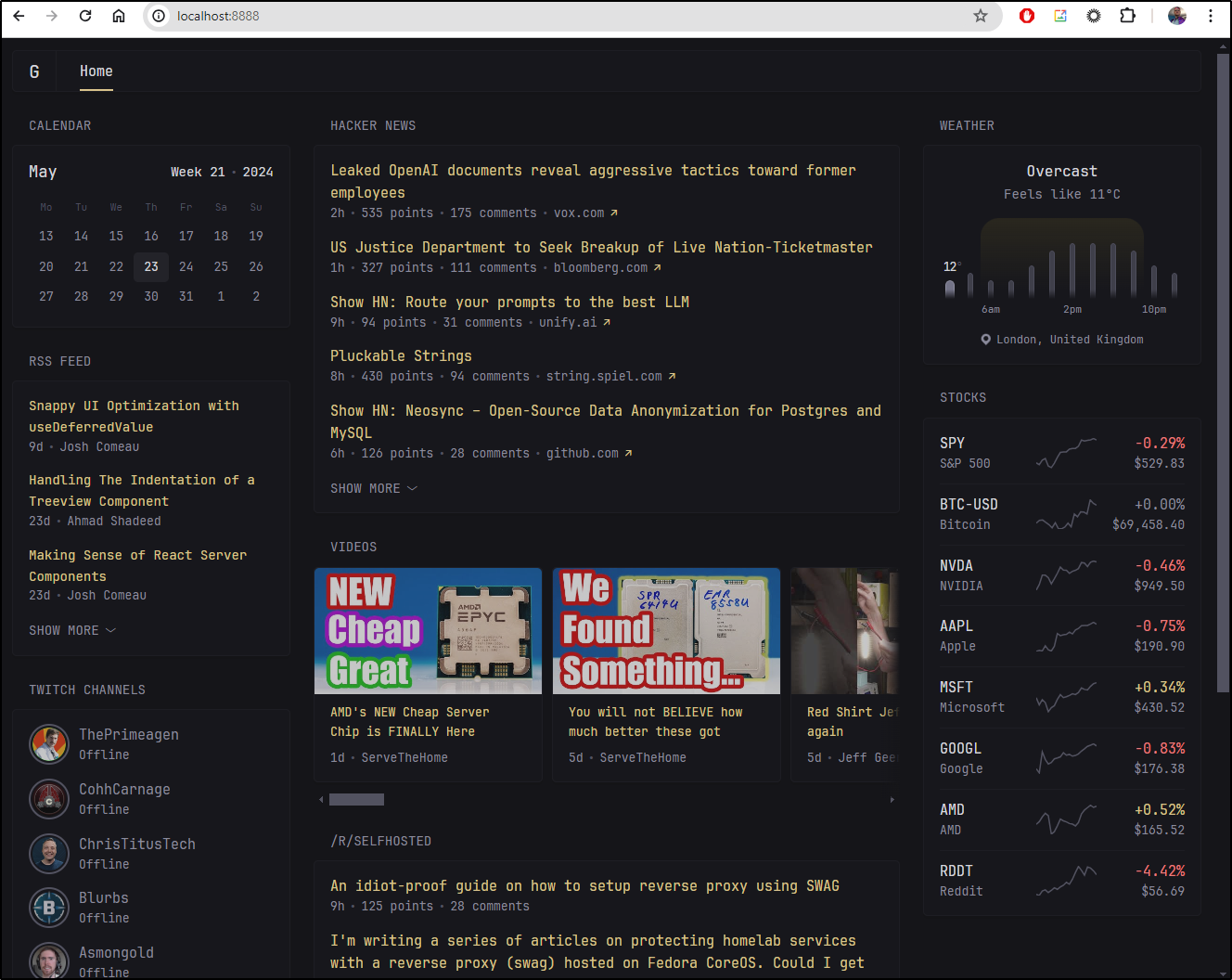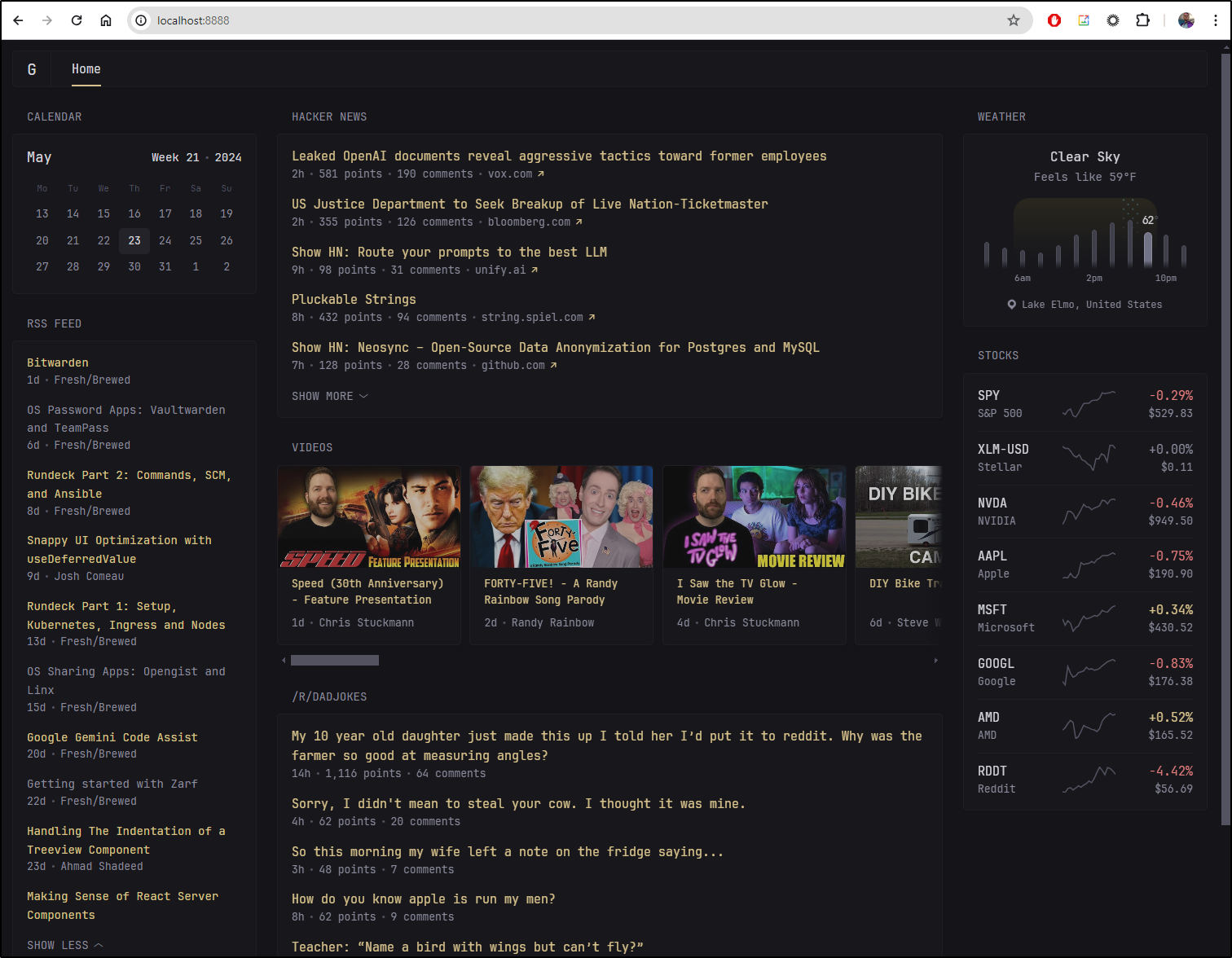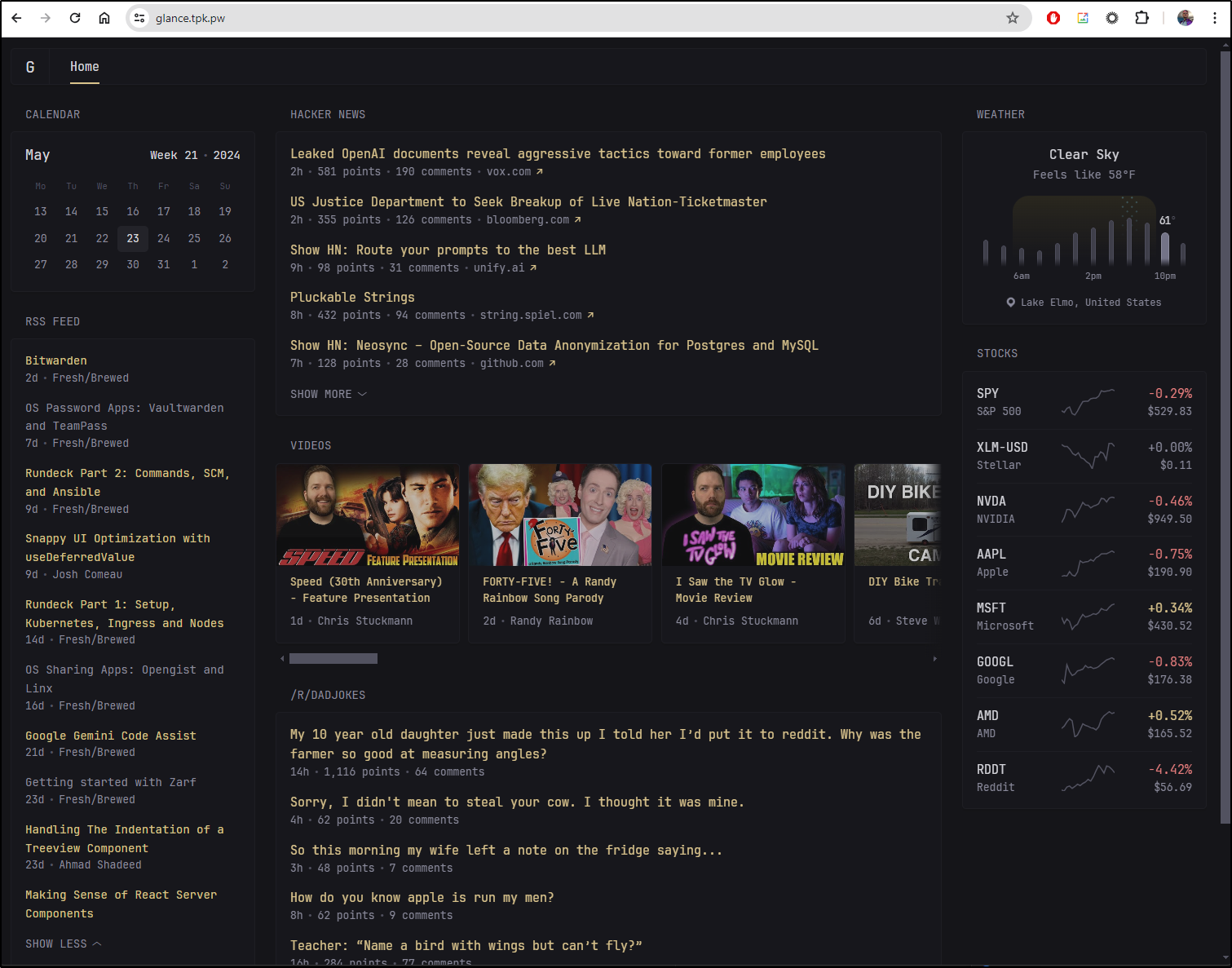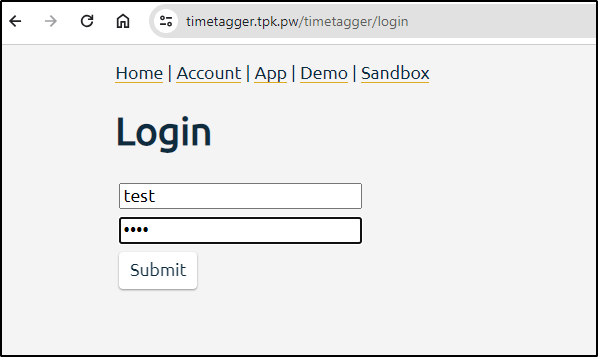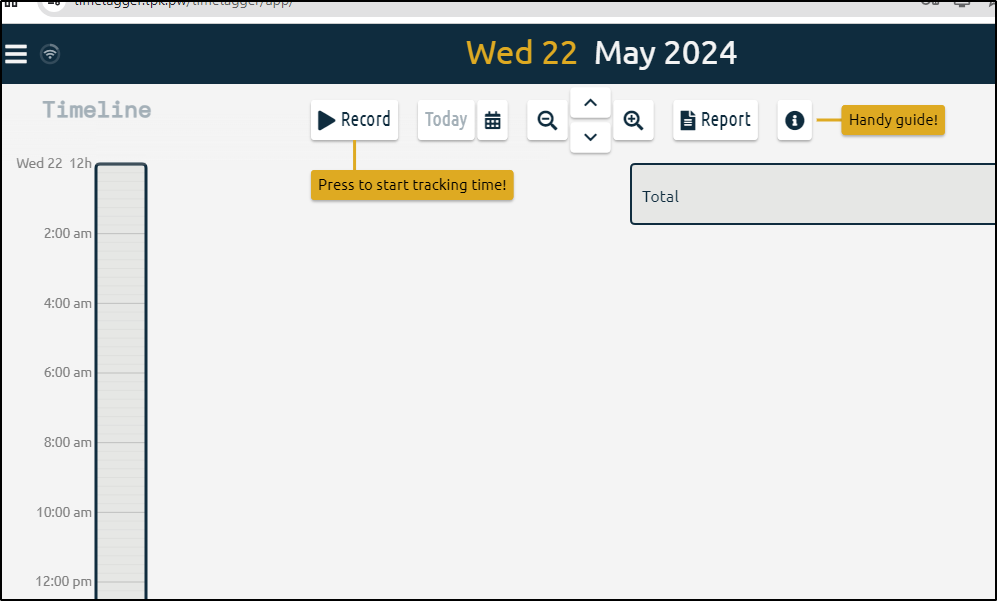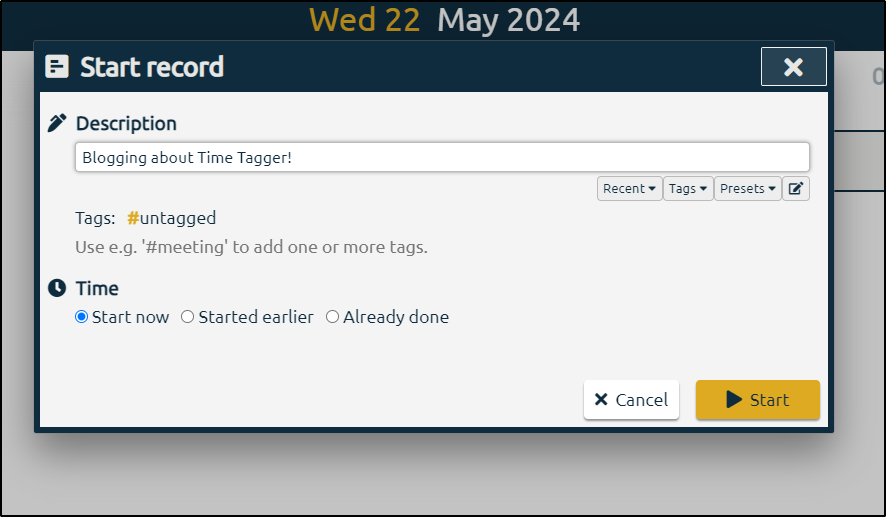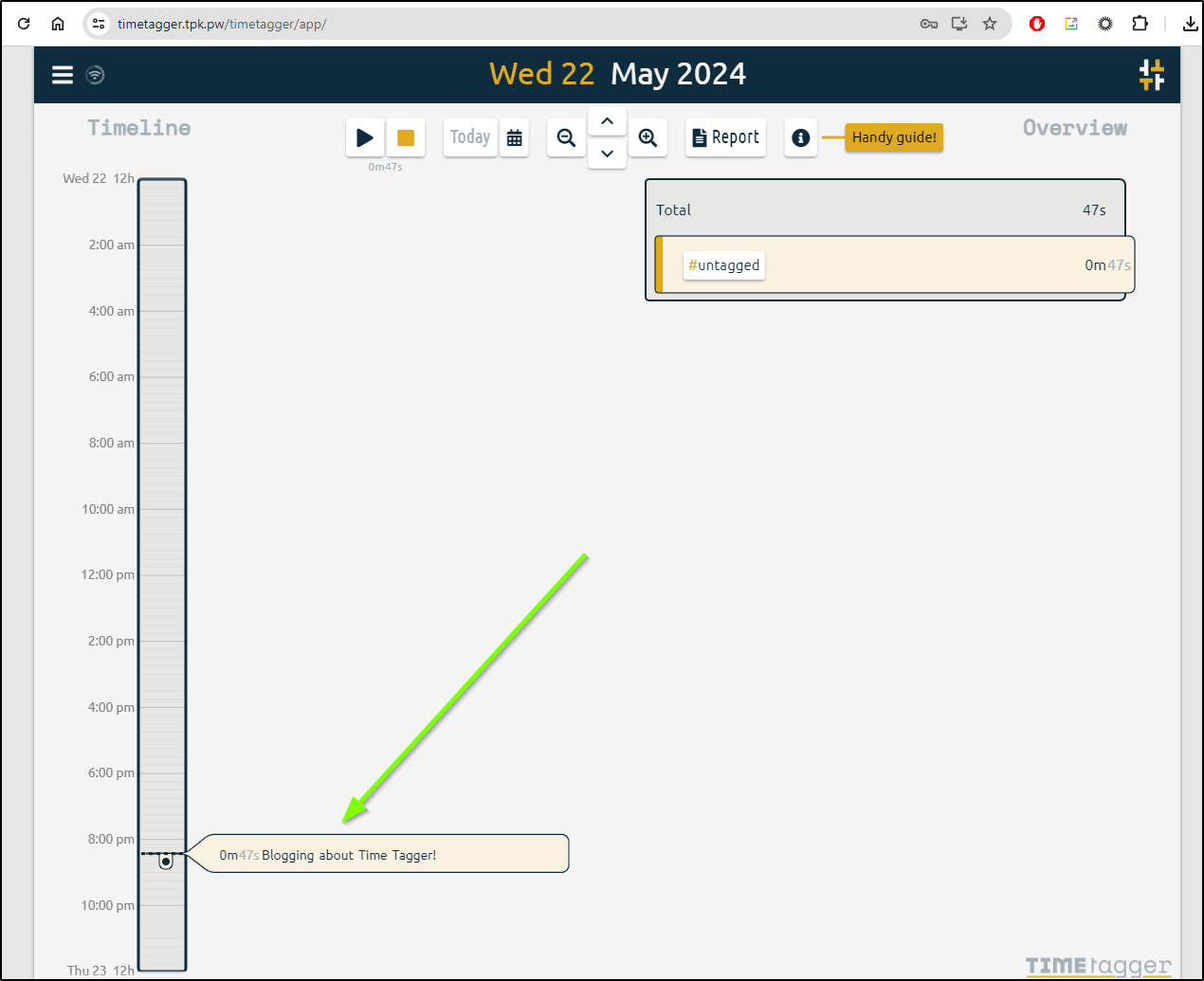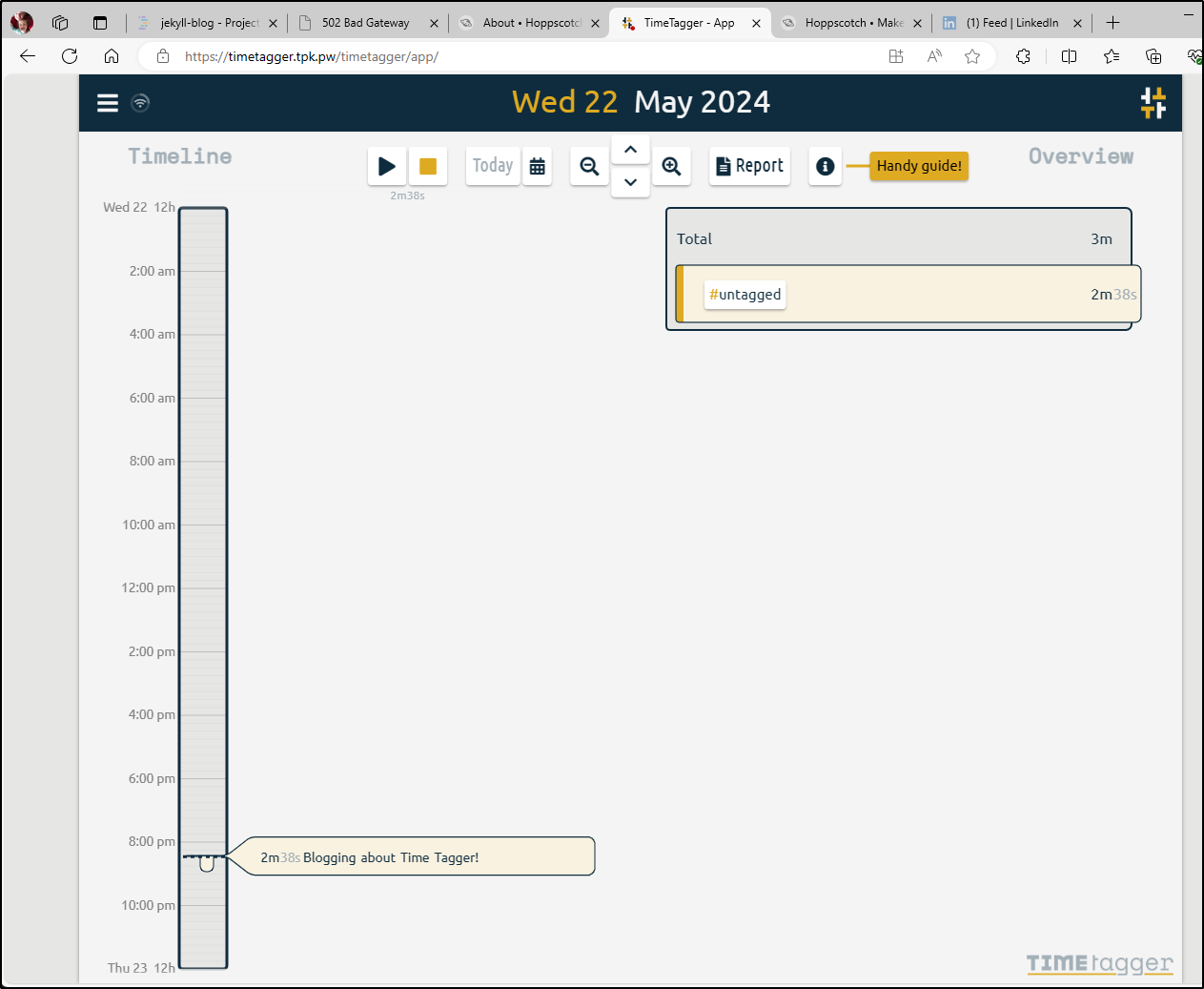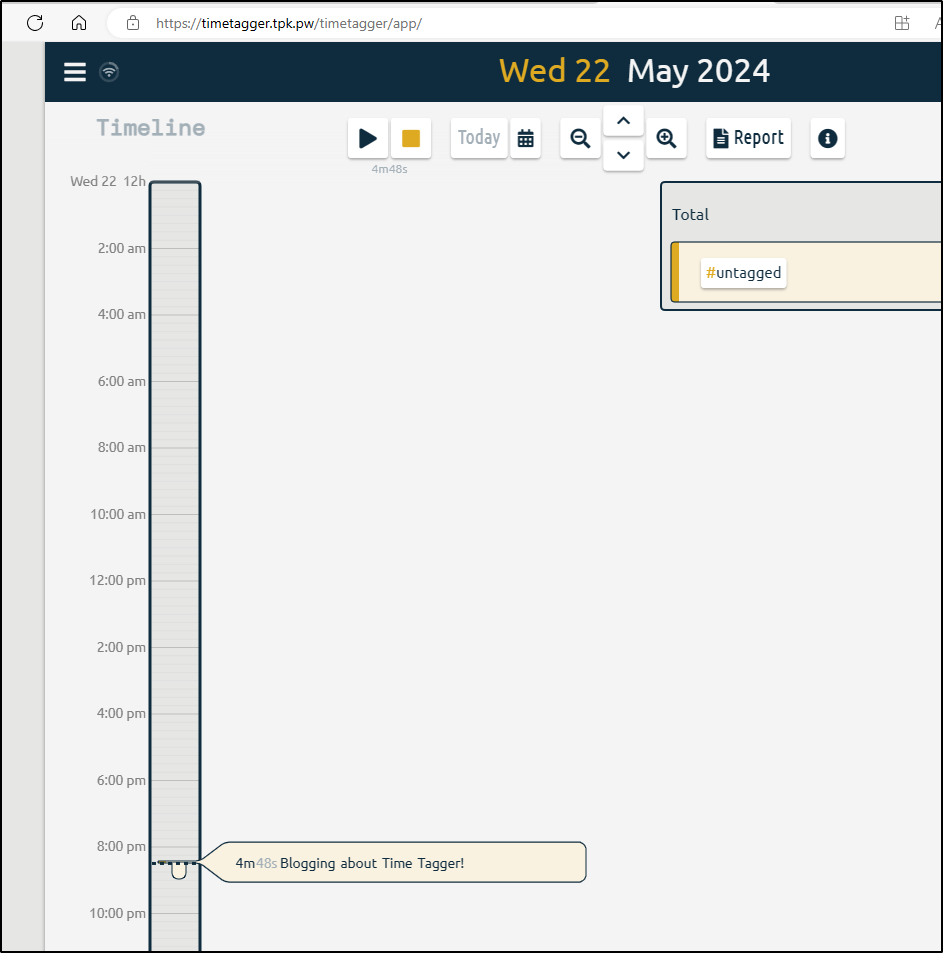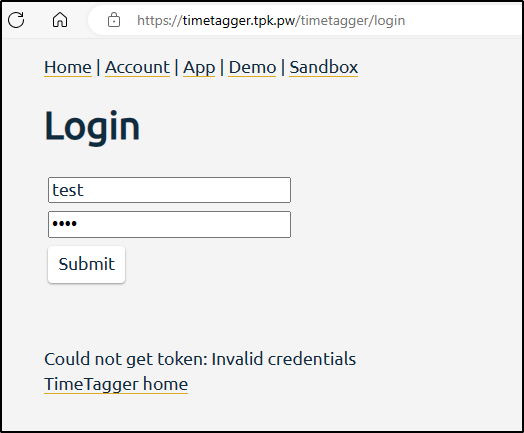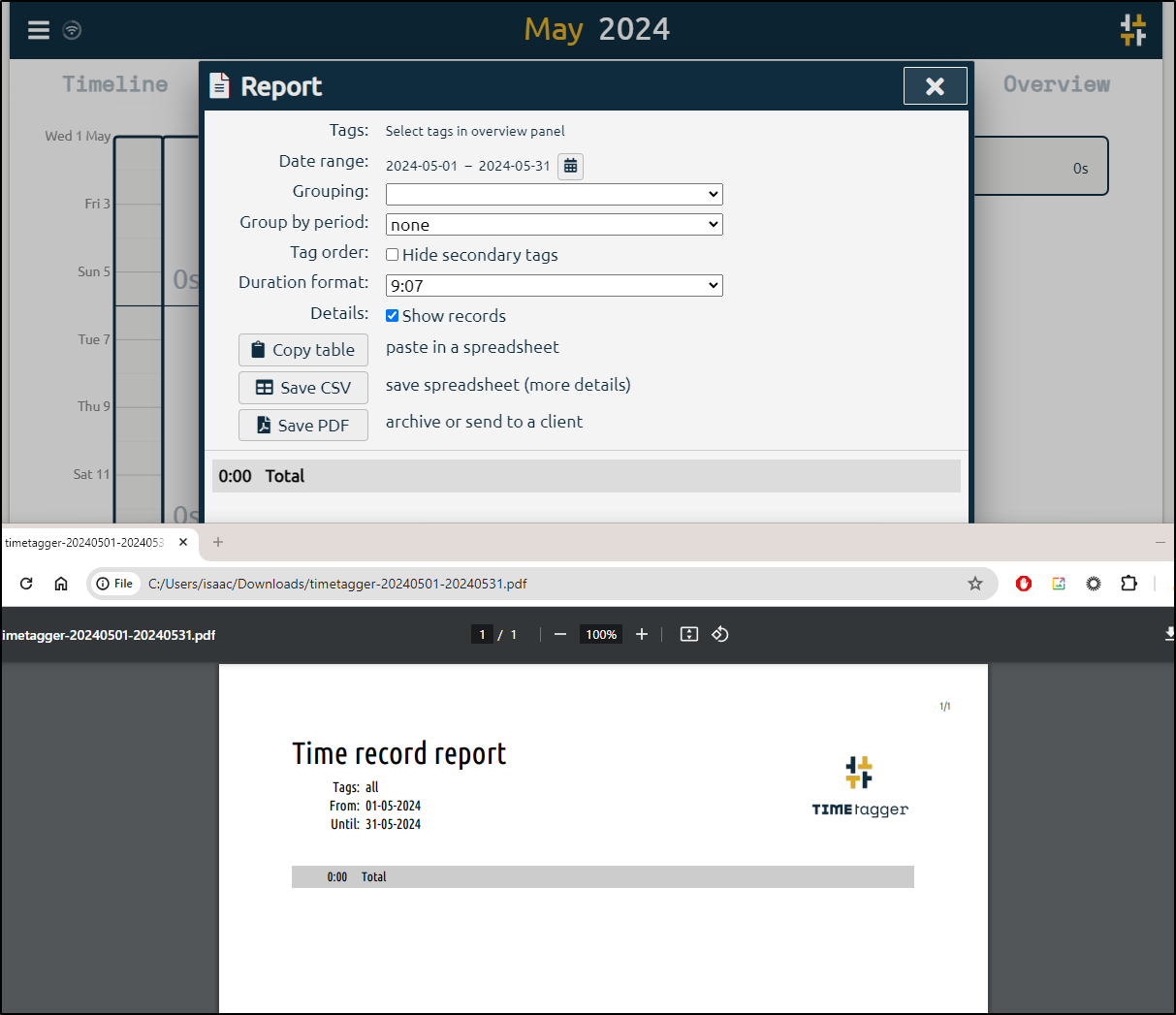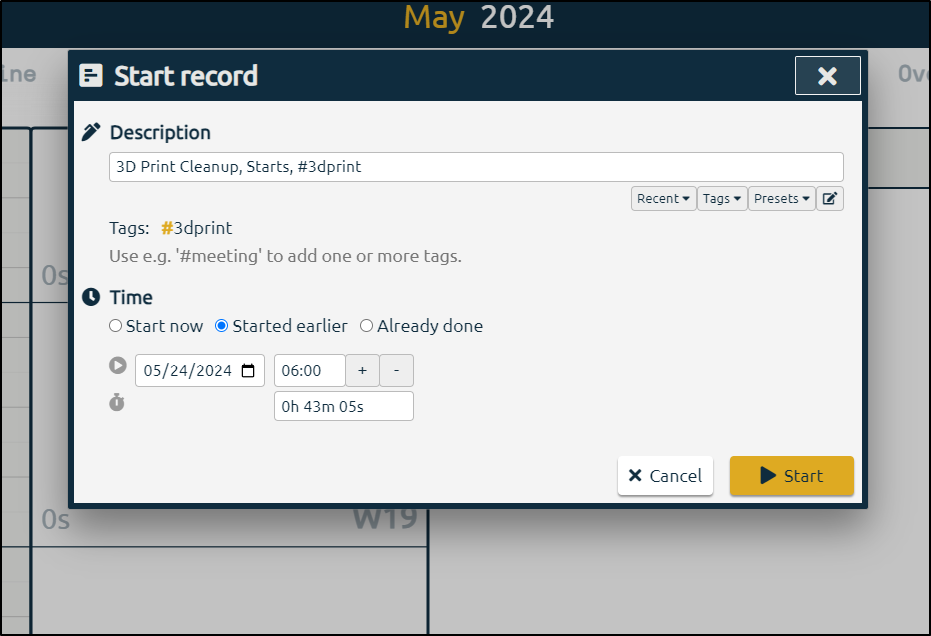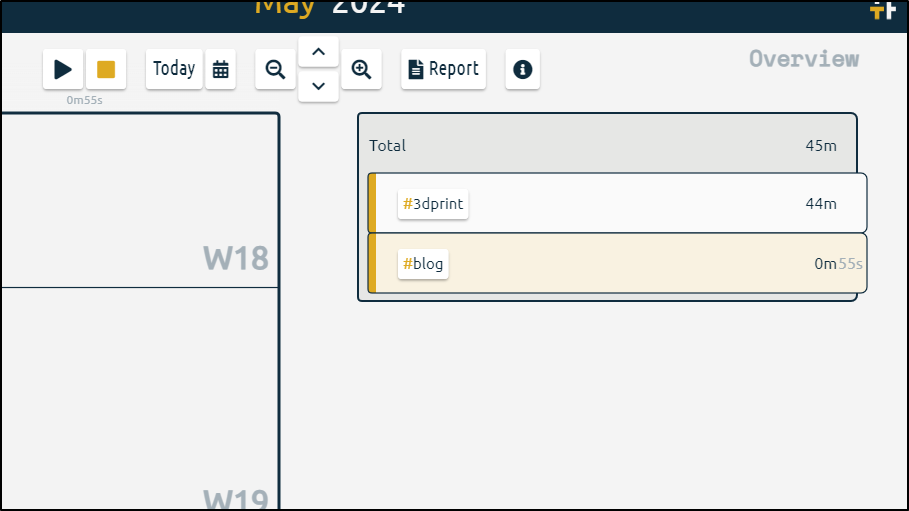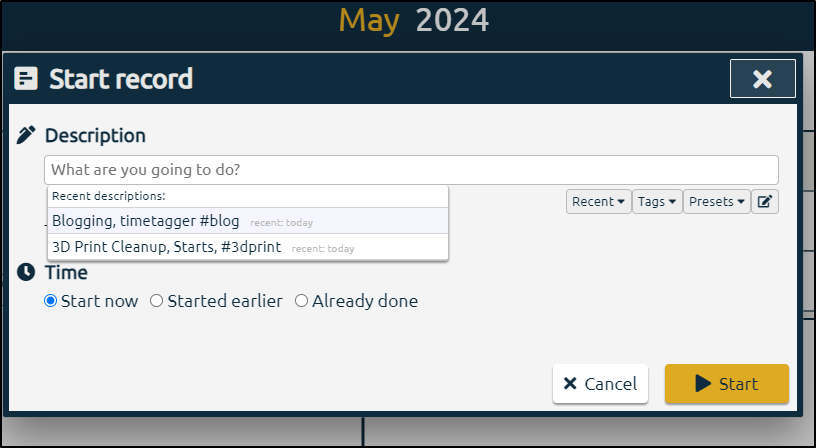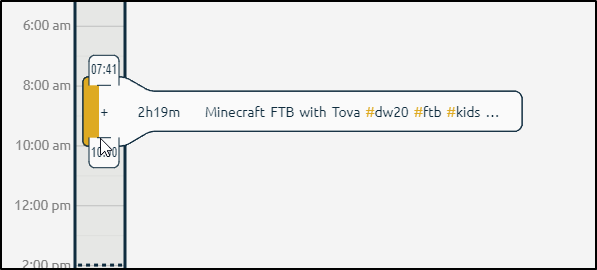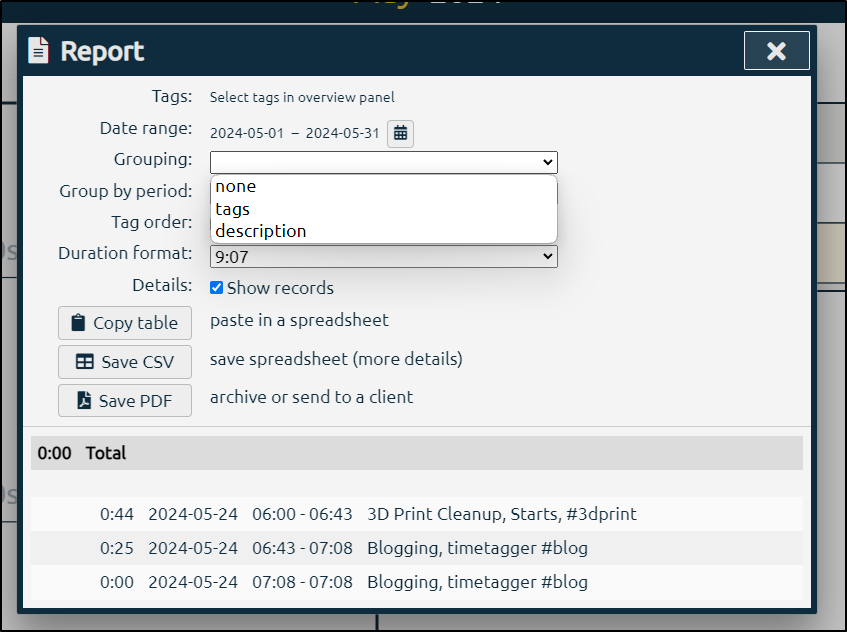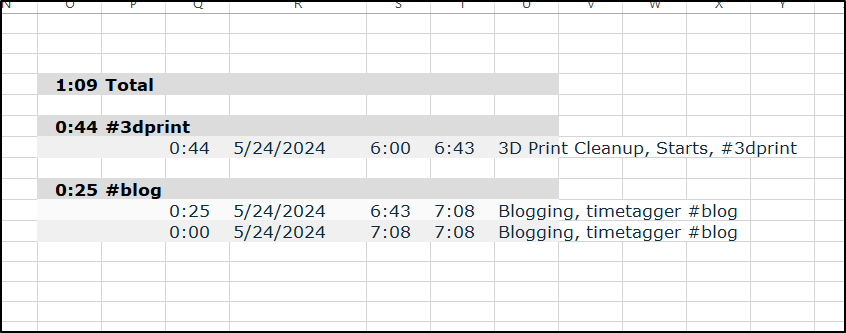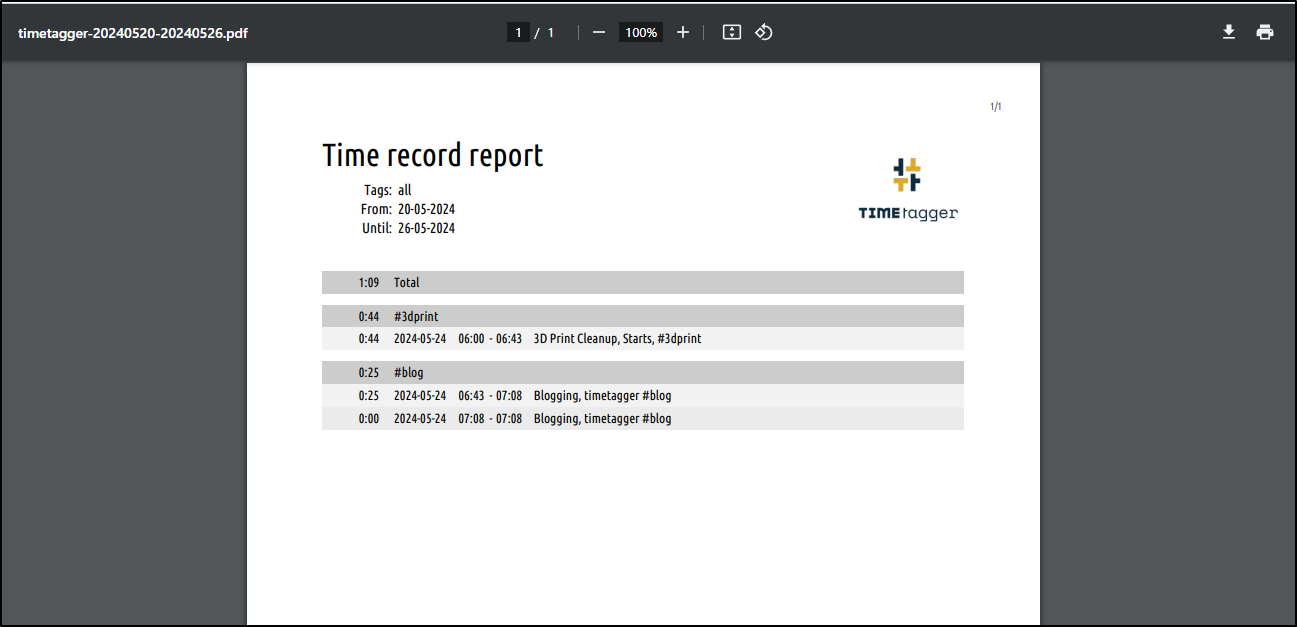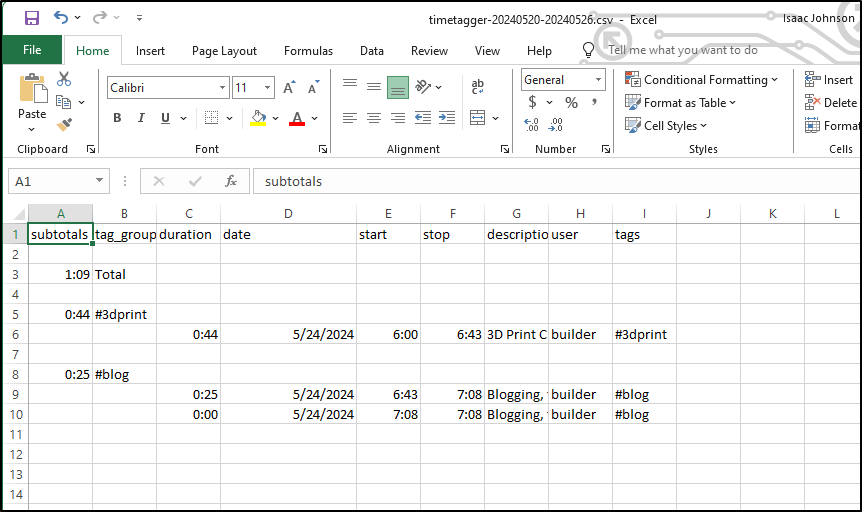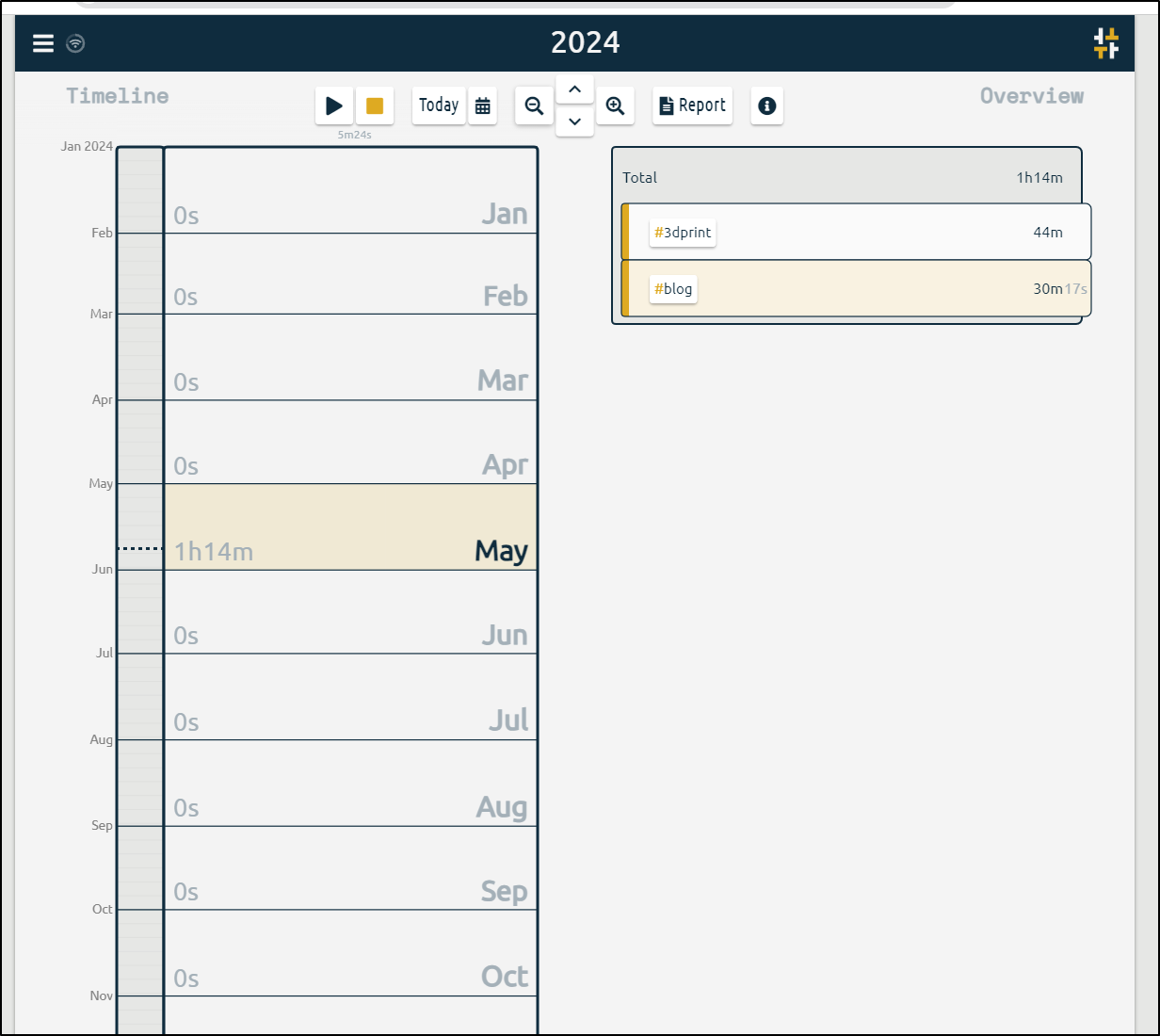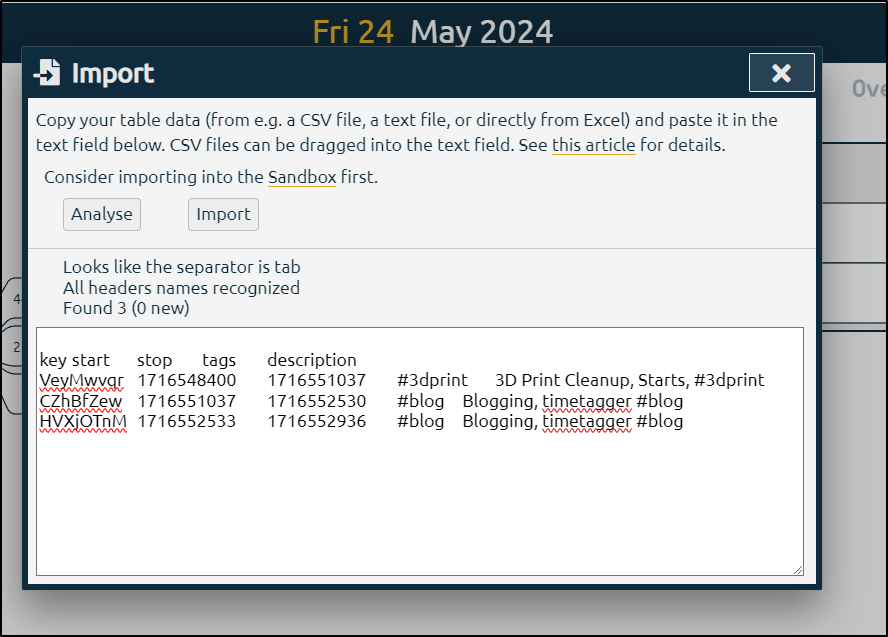Published: Jun 4, 2024 by Isaac Johnson
I had two bookmarked apps I wanted to check out that originally were mentioned on MariusHosting. The first is a landing page that is YAML driven called Glance. Glance is easy to install and configure - probably the best I’ve tried thus far.
The other app I wanted to check out is TimeTagger which can be hosted in Docker or Kubernetes and is used to just keep a log of time spent on things.
Let’s start with Glance.
Glance
I came across Glance from a MariusHosting post.
The Github page points out we can just launch with docker using
docker run -d -p 8080:8080 \
-v ./glance.yml:/app/glance.yml \
-v /etc/timezone:/etc/timezone:ro \
-v /etc/localtime:/etc/localtime:ro \
glanceapp/glance
A little bit buried in the docs is an example glance.yml file: https://github.com/glanceapp/glance/blob/main/docs/configuration.md#preconfigured-page
pages:
- name: Home
columns:
- size: small
widgets:
- type: calendar
- type: rss
limit: 10
collapse-after: 3
cache: 3h
feeds:
- url: https://ciechanow.ski/atom.xml
- url: https://www.joshwcomeau.com/rss.xml
title: Josh Comeau
- url: https://samwho.dev/rss.xml
- url: https://awesomekling.github.io/feed.xml
- url: https://ishadeed.com/feed.xml
title: Ahmad Shadeed
- type: twitch-channels
channels:
- theprimeagen
- cohhcarnage
- christitustech
- blurbs
- asmongold
- jembawls
- size: full
widgets:
- type: hacker-news
- type: videos
channels:
- UCR-DXc1voovS8nhAvccRZhg # Jeff Geerling
- UCv6J_jJa8GJqFwQNgNrMuww # ServeTheHome
- UCOk-gHyjcWZNj3Br4oxwh0A # Techno Tim
- type: reddit
subreddit: selfhosted
- size: small
widgets:
- type: weather
location: London, United Kingdom
- type: stocks
stocks:
- symbol: SPY
name: S&P 500
- symbol: BTC-USD
name: Bitcoin
- symbol: NVDA
name: NVIDIA
- symbol: AAPL
name: Apple
- symbol: MSFT
name: Microsoft
- symbol: GOOGL
name: Google
- symbol: AMD
name: AMD
- symbol: RDDT
name: Reddit
Since I like to run with Kubernetes, I’ll convert this over to a manifest with a deployment and service
apiVersion: v1
kind: ConfigMap
metadata:
name: glanceconfig
data:
glance.yml: |
pages:
- name: Home
columns:
- size: small
widgets:
- type: calendar
- type: rss
limit: 10
collapse-after: 3
cache: 3h
feeds:
- url: https://ciechanow.ski/atom.xml
- url: https://www.joshwcomeau.com/rss.xml
title: Josh Comeau
- url: https://samwho.dev/rss.xml
- url: https://awesomekling.github.io/feed.xml
- url: https://ishadeed.com/feed.xml
title: Ahmad Shadeed
- type: twitch-channels
channels:
- theprimeagen
- cohhcarnage
- christitustech
- blurbs
- asmongold
- jembawls
- size: full
widgets:
- type: hacker-news
- type: videos
channels:
- UCR-DXc1voovS8nhAvccRZhg # Jeff Geerling
- UCv6J_jJa8GJqFwQNgNrMuww # ServeTheHome
- UCOk-gHyjcWZNj3Br4oxwh0A # Techno Tim
- type: reddit
subreddit: selfhosted
- size: small
widgets:
- type: weather
location: London, United Kingdom
- type: stocks
stocks:
- symbol: SPY
name: S&P 500
- symbol: BTC-USD
name: Bitcoin
- symbol: NVDA
name: NVIDIA
- symbol: AAPL
name: Apple
- symbol: MSFT
name: Microsoft
- symbol: GOOGL
name: Google
- symbol: AMD
name: AMD
- symbol: RDDT
name: Reddit
---
apiVersion: apps/v1
kind: Deployment
metadata:
name: glance-deployment
spec:
replicas: 1
selector:
matchLabels:
app: glance
template:
metadata:
labels:
app: glance
spec:
containers:
- name: glance
image: glanceapp/glance
ports:
- containerPort: 8080
volumeMounts:
- name: config-volume
mountPath: /app/glance.yml
subPath: glance.yml
volumes:
- name: config-volume
configMap:
name: glanceconfig
---
apiVersion: v1
kind: Service
metadata:
name: glance-service
spec:
type: ClusterIP
selector:
app: glance
ports:
- protocol: TCP
port: 80
targetPort: 8080
Which I applied
$ kubectl apply -f ./manifest.yml
Warning: resource configmaps/glanceconfig is missing the kubectl.kubernetes.io/last-applied-configuration annotation which is required by kubectl apply. kubectl apply should only be used on resources created declaratively by either kubectl create --save-config or kubectl apply. The missing annotation will be patched automatically.
configmap/glanceconfig configured
deployment.apps/glance-deployment created
service/glance-service created
Seems it doesn’t like that CM
$ kubectl get pods -l app=glance
NAME READY STATUS RESTARTS AGE
glance-deployment-5547d948ff-69h6q 1/1 Running 0 46s
I can now port-forward to test
$ kubectl port-forward svc/glance-service 8888:80
Forwarding from 127.0.0.1:8888 -> 8080
Forwarding from [::1]:8888 -> 8080
Handling connection for 8888
Handling connection for 8888
One thing I realized is that when I change the Configmap, it doesn’t live update. This is because we mount as a volume on the pod. What that means is that if you update your glance.yml, you need to also bounce the pod to make it take effect
builder@LuiGi:~/Workspaces/glance$ kubectl apply -f ./manifest.yml
configmap/glanceconfig configured
deployment.apps/glance-deployment unchanged
service/glance-service unchanged
builder@LuiGi:~/Workspaces/glance$ kubectl port-forward svc/glance-service 8888:80
Forwarding from 127.0.0.1:8888 -> 8080
Forwarding from [::1]:8888 -> 8080
Handling connection for 8888
Handling connection for 8888
^Cbuilder@LuiGi:~/Workspaces/glance$ kubectl get pods -l app=glance
NAME READY STATUS RESTARTS AGE
glance-deployment-5547d948ff-69h6q 1/1 Running 0 11m
builder@LuiGi:~/Workspaces/glance$ kubectl delete pod glance-deployment-5547d948ff-69h6q
pod "glance-deployment-5547d948ff-69h6q" deleted
or a bit easier
builder@LuiGi:~/Workspaces/glance$ kubectl apply -f ./manifest.yml
configmap/glanceconfig configured
deployment.apps/glance-deployment unchanged
service/glance-service unchanged
builder@LuiGi:~/Workspaces/glance$ kubectl delete pod -l app=glance
pod "glance-deployment-5547d948ff-s8cqk" deleted
Once I got it configured to my tastes
I figured I might as well expose it, perhaps I can use it as a landing page. At the very least, I can keep an eye on my RSS feed
I need to make an A Record
$ az account set --subscription "Pay-As-You-Go" && az network dns record-set a add-record -g idjdnsrg -z tpk.pw -a 75.73.224.240 -n glance
{
"ARecords": [
{
"ipv4Address": "75.73.224.240"
}
],
"TTL": 3600,
"etag": "2c7054da-e087-4fa9-95f1-3b8da2b08d20",
"fqdn": "glance.tpk.pw.",
"id": "/subscriptions/d955c0ba-13dc-44cf-a29a-8fed74cbb22d/resourceGroups/idjdnsrg/providers/Microsoft.Network/dnszones/tpk.pw/A/glance",
"name": "glance",
"provisioningState": "Succeeded",
"resourceGroup": "idjdnsrg",
"targetResource": {},
"trafficManagementProfile": {},
"type": "Microsoft.Network/dnszones/A"
}
Then I can create an ingress to that same service
builder@LuiGi:~/Workspaces/glance$ cat glance.tpk.yaml
apiVersion: networking.k8s.io/v1
kind: Ingress
metadata:
annotations:
cert-manager.io/cluster-issuer: azuredns-tpkpw
ingress.kubernetes.io/ssl-redirect: "true"
kubernetes.io/ingress.class: nginx
kubernetes.io/tls-acme: "true"
nginx.ingress.kubernetes.io/ssl-redirect: "true"
name: glance-ingress
spec:
rules:
- host: glance.tpk.pw
http:
paths:
- backend:
service:
name: glance-service
port:
number: 80
path: /
pathType: Prefix
tls:
- hosts:
- glance.tpk.pw
secretName: glance-tls
builder@LuiGi:~/Workspaces/glance$ kubectl apply -f ./glance.tpk.yaml
ingress.networking.k8s.io/glance-ingress created
Once I see the cert is satisified
builder@LuiGi:~/Workspaces/glance$ kubectl get cert glance-tls
NAME READY SECRET AGE
glance-tls False glance-tls 38s
builder@LuiGi:~/Workspaces/glance$ kubectl get cert glance-tls
NAME READY SECRET AGE
glance-tls False glance-tls 63s
glance-tls False glance-tls 78s
builder@LuiGi:~/Workspaces/glance$ kubectl get cert glance-tls
NAME READY SECRET AGE
glance-tls True glance-tls 84s
I can test https://glance.tpk.pw/
It’s really quite easy to update. Here we can see me changing the theme and making it live:
Time Tagger
Before I install, I’ll need to create a BCrypt password. Luckily the author made it easy by creating a utility page we can use
The same Docker compose shows the quick way to launch in Docker
version: "3"
services:
timetagger:
image: ghcr.io/almarklein/timetagger
ports:
- "80:80"
volumes:
- ./_timetagger:/root/_timetagger
environment:
- TIMETAGGER_BIND=0.0.0.0:80
- TIMETAGGER_DATADIR=/root/_timetagger
- TIMETAGGER_LOG_LEVEL=info
- TIMETAGGER_CREDENTIALS=test:$$2a$$08$$zMsjPEGdXHzsu0N/felcbuWrffsH4.4ocDWY5oijsZ0cbwSiLNA8. # test:test
I’ll turn this into a Kuberntes YAML manifest and launch it
$ cat timetagger.manifest.yaml
apiVersion: v1
kind: PersistentVolumeClaim
metadata:
name: timetagger-pvc
spec:
accessModes:
- ReadWriteOnce
resources:
requests:
storage: 1Gi
---
apiVersion: apps/v1
kind: Deployment
metadata:
name: timetagger-deployment
spec:
replicas: 1
selector:
matchLabels:
app: timetagger
template:
metadata:
labels:
app: timetagger
spec:
containers:
- name: timetagger
image: ghcr.io/almarklein/timetagger
ports:
- containerPort: 80
env:
- name: TIMETAGGER_BIND
value: "0.0.0.0:80"
- name: TIMETAGGER_DATADIR
value: "/root/_timetagger"
- name: TIMETAGGER_LOG_LEVEL
value: "info"
- name: TIMETAGGER_CREDENTIALS
value: "test:$$2a$$08$$zMsjPEGdXHzsu0N/felcbuWrffsH4.4ocDWY5oijsZ0cbwSiLNA8."
volumeMounts:
- name: timetagger-volume
mountPath: /root/_timetagger
volumes:
- name: timetagger-volume
persistentVolumeClaim:
claimName: timetagger-pvc
---
apiVersion: v1
kind: Service
metadata:
name: timetagger-service
spec:
selector:
app: timetagger
ports:
- protocol: TCP
port: 80
targetPort: 80
$ kubectl apply -f ./timetagger.manifest.yaml
persistentvolumeclaim/timetagger-pvc created
deployment.apps/timetagger-deployment created
service/timetagger-service created
I can see it’s running
$ kubectl get pods -l app=timetagger
NAME READY STATUS RESTARTS AGE
timetagger-deployment-75c5df6d65-bhht8 1/1 Running 0 65s
I’ll skip to creating the Ingress now as well
$ az account set --subscription "Pay-As-You-Go" && az network dns record-set a add-record -g idjdnsrg -z tpk.pw -a 75.73.224.240 -n timetagger
{
"ARecords": [
{
"ipv4Address": "75.73.224.240"
}
],
"TTL": 3600,
"etag": "a72c0b63-971a-4a1b-a808-98fb5e374592",
"fqdn": "timetagger.tpk.pw.",
"id": "/subscriptions/d955c0ba-13dc-44cf-a29a-8fed74cbb22d/resourceGroups/idjdnsrg/providers/Microsoft.Network/dnszones/tpk.pw/A/timetagger",
"name": "timetagger",
"provisioningState": "Succeeded",
"resourceGroup": "idjdnsrg",
"targetResource": {},
"trafficManagementProfile": {},
"type": "Microsoft.Network/dnszones/A"
}
Then, as before, fire off the Ingress
$ cat timetagger.tpk.yaml
apiVersion: networking.k8s.io/v1
kind: Ingress
metadata:
annotations:
cert-manager.io/cluster-issuer: azuredns-tpkpw
ingress.kubernetes.io/ssl-redirect: "true"
kubernetes.io/ingress.class: nginx
kubernetes.io/tls-acme: "true"
nginx.ingress.kubernetes.io/ssl-redirect: "true"
name: timetagger-ingress
spec:
rules:
- host: timetagger.tpk.pw
http:
paths:
- backend:
service:
name: timetagger-service
port:
number: 80
path: /
pathType: Prefix
tls:
- hosts:
- timetagger.tpk.pw
secretName: timetagger-tls
$ kubectl apply -f ./timetagger.tpk.yaml
ingress.networking.k8s.io/timetagger-ingress created
Once the cert was ready, I could test
builder@LuiGi:~/Workspaces/glance$ kubectl get cert timetagger-tls
NAME READY SECRET AGE
timetagger-tls False timetagger-tls 53s
builder@LuiGi:~/Workspaces/glance$ kubectl get cert timetagger-tls
NAME READY SECRET AGE
timetagger-tls True timetagger-tls 2m7s
I can then press record to start tracking time
I’ll give it a note
I can see it tracking my time
What is pretty nice is that the time is not Javascript or browser dependent.
I was able to login to a different browser and see it maintained the time tag
How fault tolerant is it? Does it use the PVC?
Let’s rotate the pod and check
builder@LuiGi:~/Workspaces/glance$ kubectl get pods -l app=timetagger
NAME READY STATUS RESTARTS AGE
timetagger-deployment-75c5df6d65-bhht8 1/1 Running 0 11m
builder@LuiGi:~/Workspaces/glance$ kubectl delete pods -l app=timetagger
pod "timetagger-deployment-75c5df6d65-bhht8" deleted
builder@LuiGi:~/Workspaces/glance$ kubectl get pods -l app=timetagger
NAME READY STATUS RESTARTS AGE
timetagger-deployment-75c5df6d65-6k2qf 1/1 Running 0 8s
It still is recording!
I’ll try another radical change and switch users. I moved from a test user to builder with a different password
$ kubectl apply -f ./timetagger.manifest.yaml
persistentvolumeclaim/timetagger-pvc unchanged
deployment.apps/timetagger-deployment configured
service/timetagger-service unchanged
Test no longer works
Forgetting to stop
I started it and then planned to stop that Blogging activity that night. I forgot.
Coming back two days later, that entry seems to have disappeared
I’ll try adding some time today. So today I spent my first 45m cleaning some 3d prints, restarting a project and just general 3d Printing right-brain work
I noticed that if I start a new activity, the old one is done. Perhaps that makes sense, tracking simultaneous work might be a challenge. That said, it’s good to know the behavior.
I can always restart a task by looking at recent entries. It doesn’t create a duplicate, just adds more time (continues the clock)
One can also grab a start or stop time in the page and click-hold-drag to move it to a new start/stop time
Reporting
Clicking “Report” will show recent entries and allow us to group by tags or description
For instance, a report of this week grouped by tag
If I copy table, this is what ends up in the clipboard:
1:09 Total
0:44 #3dprint
0:44 2024-05-24 06:00 06:43 3D Print Cleanup, Starts, #3dprint
0:25 #blog
0:25 2024-05-24 06:43 07:08 Blogging, timetagger #blog
0:00 2024-05-24 07:08 07:08 Blogging, timetagger #blog
which pastes just fine into Excel
The PDF has a nice breakdown by time
And, of course, the CSV imports into Excel jsut fine as well
We can use the zoom buttons to zoom in and out with ease
A little bit of usage:
Backups
We can copy our data out, however it is just to the clipboard
I thought the import was nice in that it automatically eliminates existing duplicate entries
Summary
I hope you found at least one of these apps to be of use. I enjoyed Glance as a very easy to launch and configure landing page. It was easy to turn it into a Kubernetes app using a configmap for the config YAML.
Timetagger is a very fast little app. I’m surprised how feature rich it is. I plan to try and use it for a few side projects. I only wish I could have multiple users (or identities).


